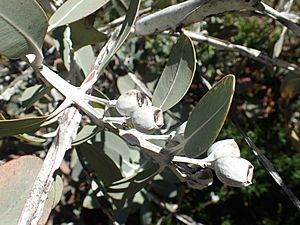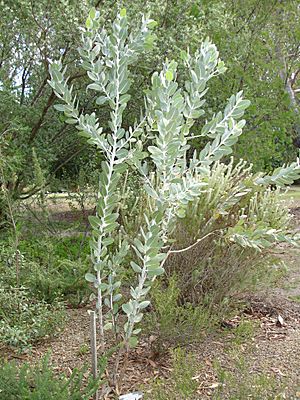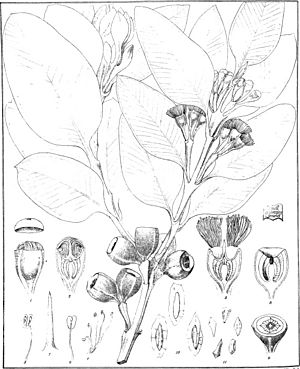Tallerack facts for kids
Quick facts for kids Tallerack |
|
|---|---|
 |
|
| Foliage and fruit of Eucalyptus pleurocarpa in Kings Park | |
| Scientific classification | |
| Genus: |
Eucalyptus
|
| Species: |
pleurocarpa
|
| Synonyms | |

The Eucalyptus pleurocarpa, also known as tallerack or talyerock, is a special type of mallee tree. It is found only in the southwest part of Western Australia. This plant is easy to spot because of its smooth bark and its unique grey or bluish-green leaves.
Its leaves are usually arranged in pairs. When it flowers, you'll see whitish flowers and then barrel-shaped fruits. A cool fact about the tallerack is that its stamens (the parts of the flower that make pollen) are grouped together in four clusters.
Contents
What Does the Tallerack Look Like?
The tallerack is a mallee, which means it's a type of eucalyptus that grows many thin stems from its base, like a bush. It usually grows to be about 2 to 5 meters (6.5 to 16 feet) tall and 3 to 6 meters (10 to 20 feet) wide. It has smooth, greyish bark.
The plant has a spreading shape, sometimes looking a bit messy, with many thin stems. Its leaves are thick, tough, and have a waxy, bluish-grey color. The flower buds, fruits, and even the stems are white and waxy, which makes them stand out.
Young Plants and Leaves
Young tallerack plants have stems that are square-shaped with a small "wing" on each corner. Their leaves are egg-shaped to oblong, about 10 to 12 centimeters (4 to 4.7 inches) long and 6 to 6.5 centimeters (2.4 to 2.6 inches) wide. These young leaves are also arranged in opposite pairs.
Adult leaves are quite similar to the young ones. They are dull greyish-green on both sides and are broadly spear-shaped or egg-shaped. They can be 4.5 to 14 centimeters (1.8 to 5.5 inches) long and 2.5 to 7 centimeters (1 to 2.8 inches) wide.
Flowers and Fruit
The flower buds grow in groups of three where the leaves meet the stem. Each group of buds sits on a flattened stalk about 6 to 18 millimeters (0.2 to 0.7 inches) long. The individual buds are oval-shaped, about 8 to 13 millimeters (0.3 to 0.5 inches) long.
When the buds are ready to open, they have a four-sided base and a rounded cap. The flowers are whitish and usually bloom from January to April or from October to December. After flowering, the plant produces woody, barrel-shaped or cube-shaped fruits. These fruits are also four-sided and are about 1.2 to 2.2 centimeters (0.5 to 0.9 inches) long.
Naming the Tallerack
The scientific name for this plant, Eucalyptus pleurocarpa, was first officially described in 1844 by a scientist named Johannes Conrad Schauer. He found specimens of the plant near a place called Cape Riche in Western Australia.
The name pleurocarpa comes from ancient Greek words. Pleura means "a rib," and carpos means "fruit." This name was chosen because the fruits of this plant have ribs.
The local Noongar people, who are the traditional owners of the land where this plant grows, call it talyerock or tallerack.
Why the Name Changed
For a while, Eucalyptus pleurocarpa was sometimes called Eucalyptus tetragona. However, scientists later decided that E. pleurocarpa was the correct name because it was published earlier. Also, the original plant used to define E. tetragona was a mix between the waxy E. pleurocarpa and another non-waxy type. So, Eucalyptus tetragona is no longer the accepted name for this specific plant.
The tallerack belongs to a group of eucalypts called Eudesmia. All plants in this group have their stamens (the pollen-producing parts of the flower) arranged in four bundles, each at a corner of the square-shaped flower.
Where Does the Tallerack Grow?
Eucalyptus pleurocarpa is found in two main areas in the southwest of Western Australia. You can find it on the sandy plains from Eneabba in the north (in the Wheatbelt region) down to the areas between Albany and Esperance in the south (in the Great Southern and Goldfields-Esperance regions).
It prefers to grow in grey or white sandy soils, which sometimes also contain gravel. It often stands out in areas of shrubby heathland, which are open areas with many small bushes. Other eucalyptus trees that grow near the tallerack include E. decipiens, E. falcata, and E. wandoo.
How We Use Tallerack
The tallerack is a great plant for gardens, especially in dry or semi-dry places, just like many other mallees.
It is often sold as an ornamental plant because it looks so unique. Its beautiful flowers and waxy foliage are also used by florists as cut flowers in arrangements. This plant can handle dry conditions well, but it doesn't like frost. It can grow in different types of soil as long as it gets plenty of sunshine.



